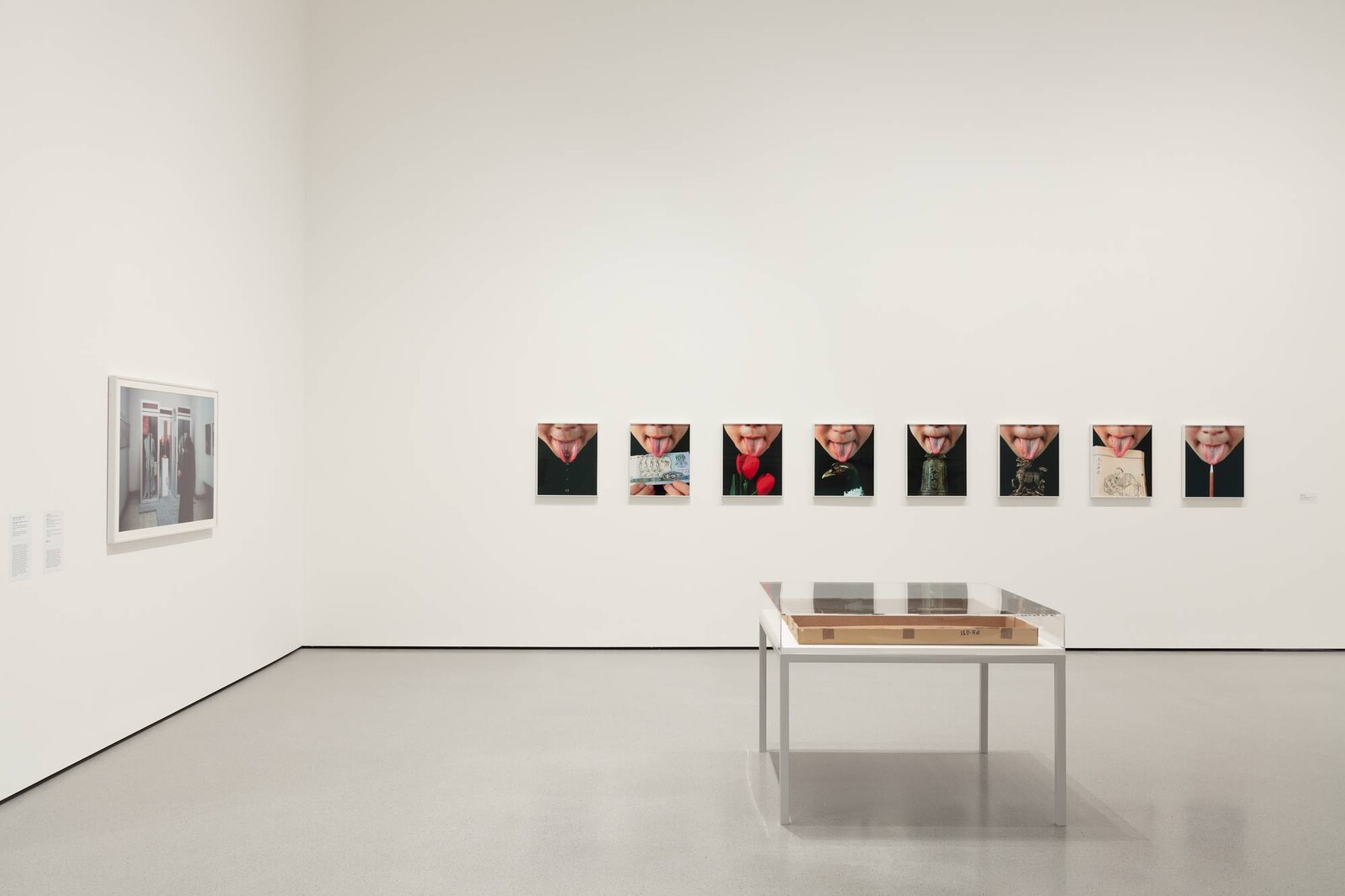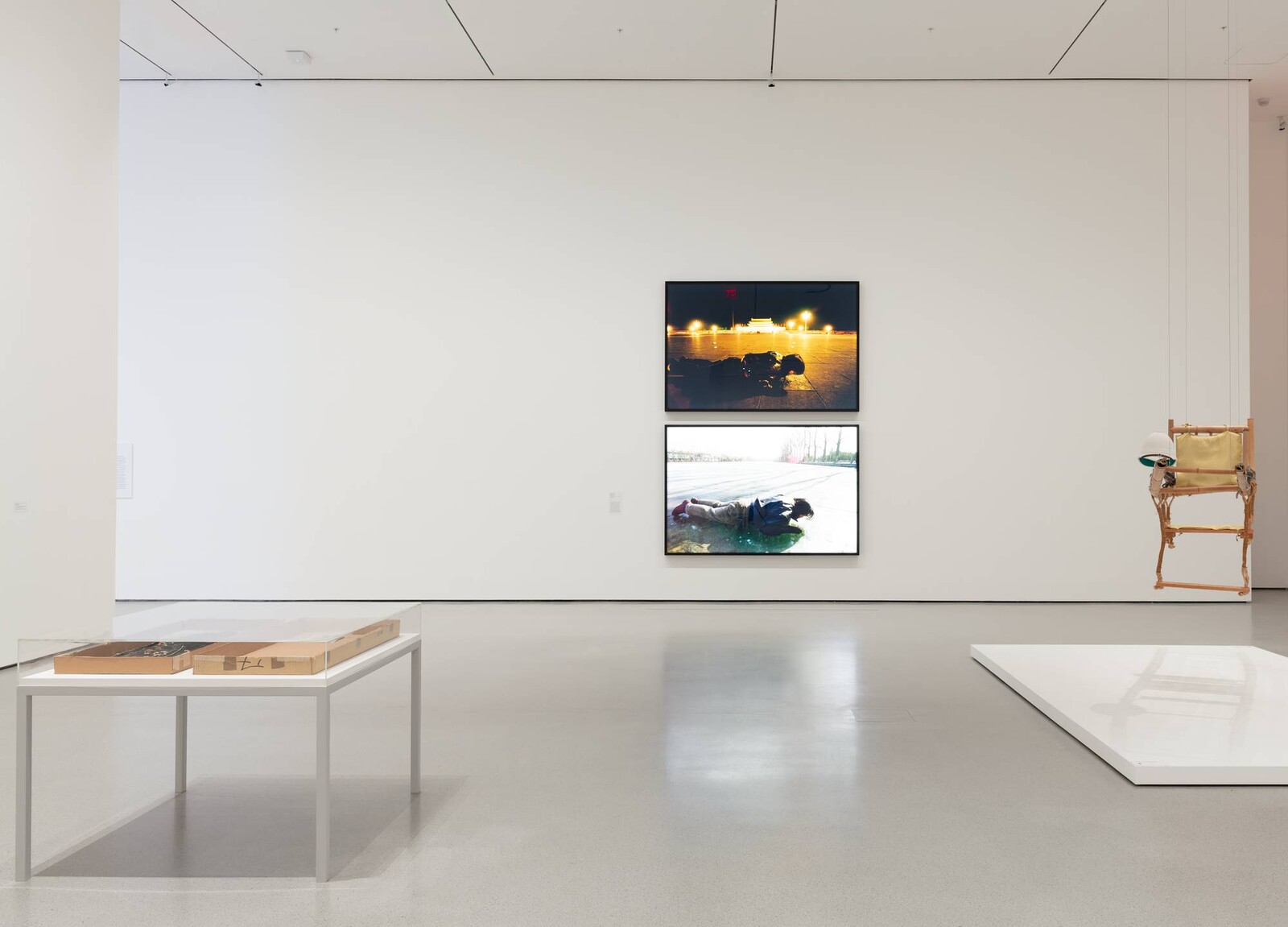Imagine a curated overview of contemporary art from the United States titled “Before and After the Vietnam War.” Imagine the case not as a new direction for explorative scholarship but as the perpetuating, defining framework, over and over again. “Before and After Tiananmen,” Gallery 207 in the 2019 rehang of the permanent collection of the Museum of Modern Art, New York, presents established Chinese artists such as Xu Bing, Zhang Peili, Huang Yong Ping, and Song Dong in a sparse installation. Yet it registers not as a progressive move towards more inclusive and nuanced narratives of modern and postmodern art worldwide, but rather as a form of institutional gaslighting that raises deeper and stickier issues than the more manifest ills of exclusion or erasure. Reflecting a growing institutional recognition of heterogeneous global modernisms, it illustrates where that promise of progressive inclusivity falls short—and flat—if the historical framing remains uncontested, and situated knowledges are routinely overlooked. Presenting these alternative trajectories using the criteria and assumptions of the old canon—essentially treating them as outposts of western art history—will always miss the mark, limiting the discourse while purporting to expand it.
It is telling that in most reviews of the new MoMA, this particular gallery is mentioned in passing, if at all.1 By essentializing Tiananmen—a turning point that contributed more to the rise of the market than to the development of the Chinese avant-garde—and perpetuating a familiar western narrative about modern China without rigorous qualification, MoMA flattens the works into a digestible, and misconstrued, anti-authoritarian narrative. In doing so, it misses opportunities to illuminate these artists in more meaningful ways. More substantial connections might have been drawn with examples of socialist modernism in the MoMA collection.2 Exhibited as separate clusters at MoMA, modern and contemporary Chinese and Latin American art have been engaged in long, fruitful, revolutionary conversations throughout the twentieth century: David Alfaro Siqueiros, for example, directly acknowledged his indebtedness to the 1930s New Woodcut Movement in China—an anti-imperialist, public-oriented visual campaign characterized by bold, visceral imagery—in works such as Proletarian Victim (1933). Originally subtitled “In Contemporary China,” it is also in the MoMA collection. This same aesthetic and political lineage informed Xu Bing’s woodcuts depicting scenes of rural life (1987–88), which are on view in the “Tiananmen” gallery. The Soviets and Mexicans were historically present, through exchanging diplomatic exhibitions from the fifties onwards and instrumentalizing the infrastructure of the Chinese art academies, where the majority of the avant-garde generation was trained—both in socialist realism and through access to western art via translated materials.
In the sleek “Tiananmen” gallery hang, the inclusion of Xiao Lu’s Dialogue, documented here as a lone photograph, initially appears exhilarating. In February 1989, the artist spontaneously fired a gun at her installation during the opening reception for the group exhibition “China/Avant-Garde” at Beijing’s China National Art Gallery (now known as the National Art Museum of China).3 Yet the crucial parameters that defined and complicated Dialogue—who procured the gun; who photographed the gunshot, co-authoring the work; the messiness of its intention, definition, and interpretation, including its engagement with feminist discourse—are omitted in the gallery label, reducing it to an anti-authoritarian spectacle that neatly aligns with the wall text’s assertion of the “insurgent spirit” of “the period marked by the 1989 student protests in Tiananmen Square.”
The wall text characterizes the room’s “defiant” artworks as having “marked a new sense of agency and international dialogue, and challenged the Chinese government’s censorship of cultural production.” In fact, they testify to the temporary relaxation of state control in the eighties that resulted in flourishing experiments in the cultural sector—of which “China/Avant-Garde” was a prime example. For the artists surveyed at MoMA and their peers, much of the intellectual groundwork was paved in the decades preceding Tiananmen. The 85 New Wave and other movements saw artists indulge in the sudden influx of translated foreign materials such as catalogues, literature, philosophical treatises during the “reading fever” of the eighties, as the country opened up after the Cultural Revolution.4 Why not introduce these art-historical terms, which are unfamiliar to western audiences? If there is merit in disrupting older chronologies in re-staging European and North American modern art, it makes no sense to conduct the same disruption and omission for discourses that lack solid introduction in the first place.
Which period—hence historiography—is marked in this “before and after” framing? Does it concern the eighties and nineties, during which most of the works on display were created? Or does the narrative stretch to include Deng Xiaoping’s economic reforms, the Cultural Revolution, and even earlier revolutionary aesthetics harnessed through exchanges with Europe, the Soviet Union, and the Global South—contexts that clearly informed Xu Bing’s mesmerizing 1980s prints? The museum seizes the provocative implication of Tiananmen without articulating the differences between “before” and “after” or sufficiently substantiating the centrality of Tiananmen through works that pointedly responded to the event. In a New York Times preview of MoMA’s reopening, Jason Farago characterized this room as “one of the bolder forays in the museum’s contemporary section” that “makes heavy demands of American audiences less familiar with Chinese history.”5
Most Chinese nationals living in the States understand, however, that Tiananmen (alongside the Cultural Revolution) is the only register of modern Chinese history for the general American public. One wonders whether MoMA contributes any new insight through this bold but uninspired gesture. For artists like Xu Bing, even moments of historical trauma such as the Cultural Revolution are more complex and entangled than its typical portrayal outside of China would suggest. His 2008 essay “Ignorance as a Kind of Nourishment” illuminates the complex confluence of historical circumstances which informed his practice: “The eighties saw a great influx of Western thought, followed by its discussion, comprehension and assimilation. But as far as I was concerned, it was all just another opportunity to mark oneself formally ‘present.’ Once [Maoist thought] has taken residence in your thought patterns, it is difficult for anything else to squeeze itself in.”6
MoMA’s “Tiananmen” gallery presents a recent brand of entrenched western-centric thinking: when combined with progressive intentions, the result is a sort of pastiche or “fan art” version of an unfamiliar, “disagreeable” art history, of which contemporary Chinese art is one symptomatic case. It is daunting considering MoMA’s steadfast investment in research initiatives such as Contemporary and Modern Art Perspectives (C-MAP), an inter-departmental research group focusing on non-western art history, and the “Primary Documents” publication series, which translates selected texts on international art. (The volume on China was published in 2010.) Institutional inclusivity should mean more than simply allowing certain works to physically occupy galleries, especially when attempting to contextualize the social and cultural histories that informed art practices outside this country—a crucial pedagogical task for globally minded museums today. To understand these works on their own grounds, to truly expand discourses, and to enliven the messiness of historical connections—at least to try—requires intellectual rigor beyond the discipline of art history. It calls for what Donna Haraway has called “situated knowledges”: a fundamental rethinking of how critical inquiries into new subjects are framed.7 One productive result of MoMA’s “Tiananmen” gallery is that it illuminates the fallacies endemic to recent attempts at progressive inclusivity: striving for diverse representation and plurality without considering historical specificity, habitually assuming “otherness” at a politically or culturally disadvantageous (but not inferior) position, and always “making sense” through mediation by the West.8
Hal Foster and Holland Cotter respectively noted: “A large gallery is given over to contemporary Chinese work”; “a permanent collection gallery devoted to contemporary art from China,” both in conjunction with the observation that an important donation of Latin American art also exists at MoMA. See Holland Cotter, “MoMA Reboots with Modernism Plus,” The New York Times (October 10, 2019), https://www.nytimes.com/2019/10/10/arts/design/moma-rehang-review-art.html and Hal Foster, “Change at MoMA,” London Review of Books (November 7, 2019), https://www.lrb.co.uk/the-paper/v41/n21/hal-foster/change-at-moma.
The notable—and only—exception is the late conceptual artist Chen Zhen’s Un Village sans frontières (2000)—a series of tiny, colorful candle houses swaddled within readymade chairs. Drawing on “his experiences in Brazil mentoring impoverished children,” according to the gallery label, this series shares a room with the architectural models of Bodys Isek Kingelez, as if to suggest either a vague pan-Southern solidarity or a crafty, third-world outsider-art vibes that might subtly reinforce a familiar fetishistic narrative.
Xiao’s piece is shown alongside works by the more recognizable names of Xu Bing, Huang Yongping, Song Dong, all of whom have—for the benefit of institutional contextualization—appeared in major recent overviews of contemporary Chinese art in New York, such as The Metropolitan Museum’s “Ink Art: Past as Present in Contemporary China” in 2013 and the Guggenheim’s “Art and China after 1989: Theater of the World” in 2018.
In 1993, Andrew Solomon wrote in The New York’s Times that “the acts of defiance of the Chinese avant-garde function very legitimately within their system, but are not designed to be interpreted within ours (…) What looks radical often is radical, but not always in the ways you think.” Andrew Solomon, “Their Irony, Humor (and Art) can save China”, The New York Times (December 19, 1993), https://www.nytimes.com/1993/12/19/magazine/their-irony-humor-and-art-can-save-china.html.
Jason Farago, “The New MoMA is Here, Get Ready for Change,” The New York Times (October 3, 2019), https://www.nytimes.com/2019/10/03/arts/design/moma-renovation.html.
Xu Bing, “Ignorance as a Kind of Nourishment,” 2008. http://www.xubing.com/en/database/essay/409.
Monika Rogowska-Stangret, “Situated Knowledges,” (2018). https://newmaterialism.eu/almanac/s/situated-knowledges.html.
I’m deeply grateful for the insightful editorial input of my Joan Tisch Teaching Fellowship colleagues (Dr. Ellen Tepfer, Vivian Crockett, Janine DeFeo, Ayanna Dozier, Grant Johnson, Joshua Lubin-Levy), Dr. John Rajchman, Dr. Jane DeBevoise, and Aubrey Knox.



